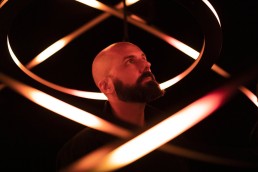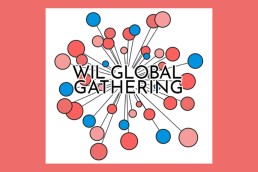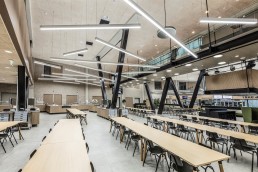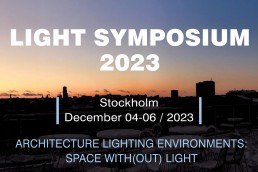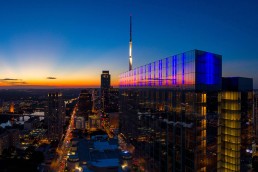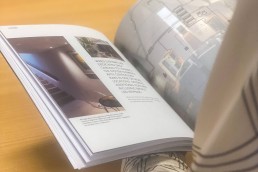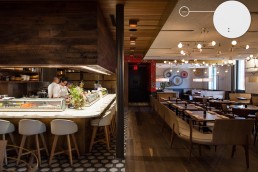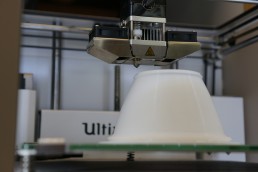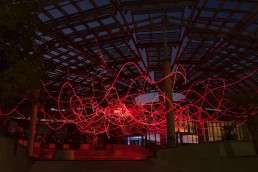IALD Chase the Dark to take place this Thursday
(Worldwide) – The 10th edition of the IALD’s Chase the Dark community event will take place around the world this Thursday, 23 March.
The programme’s name comes from the global nature of its premise: designers from the start of the International Date Line follow the rising sun as it “chases” the darkness, from Australia to the Pacific coast of the US. Encouraging participants to join in the activity, either individually or in localised gatherings, each year’s event has a theme that is the basis for individual expression, that is then shared on social media using the #IALDChaseDark hashtag.
For 2023, the programme’s theme is entitled “Shadow Play”, allowing participants to use the balance of light and dark to create displays that might involve casting unique shadow shapes, backlighting silhouettes, creating optical illusions, or anything else personally inspired.
Emma Cogswell, the lead coordinator for the Chase the Dark programme and project manager for the IALD UK region, is pleased to see the event so widely embraced for its 10th year. “Shadow is a valuable asset in a lighting designer’s toolbox,” she said. “With the ability to be projected forward or silhouetted when backlit, it’s a commonplace technique in storytelling and puppetry in a range of South Asian cultures.
“We have numerous regions and chapters coordinating in-person gatherings; form Melbourne to Mumbai, to Toronto, to San Francisco, not to mention the individual participants trying their hand at Shadow Play and joining the fun from all over the world. We can’t wait to see the results.”
The Chase the Dark event is specifically developed to encourage participating by IALD members and non-members alike, promoting the awareness and value of professional lighting design on a global scale.
Complete details of the event can be found on the IALD website here.
Christopher Bauder to deliver keynote at IALD Enlighten Europe
(Europe) – The IALD has announced that Christopher Bauder, founder of art studio WHITEvoid, will deliver a keynote session at IALD Enlighten Europe.
A multiple [d]arc award winner, Bauder is an artist that works in the fields of light and installation art, media art, and live AV performance. He focuses on the translation of bits and bytes into objects and environments, and vice versa. Space, object, sound, light, and interaction are the key elements of his work.
Enlighten Europe will be held in June, in Bauder’s native Berlin, bringing together hundreds of lighting professionals to attend sessions and discuss topics of high importance to the industry.
Christopher Knowlton, IALD CEO, is delighted to have Bauder as the headlining speaker for this year’s event. He said: “Having seen first-hand the incredible artistry that Christopher Bauder has shared with the world, and the city of Berlin in particular, it is nothing short of perfect to have him attend Enlighten and share his insight on the design, interactivity, and engineering that he demonstrates in his work.
“Designers of all tenure and scale could benefit from his understanding of the intersection between architectural illumination and the human experience, to say nothing of his groundbreaking use of media and technology.”
Christopher Bauder has brought his installations and performances to events and spaces around the world, including Centre Pompidou Paris, MUTEK Montreal, Fete des Lumieres Lyon, The National Museum of Fine Arts Taiwan, the National Centre for the Performing Arts in Beijing, and many more.
He is best known for his city-wide light art installation “LICHTGRENZE”, created in 2014 with his brother Marc Bauder, for the 25th anniversary of the Fall of the Berlin Wall.
Bauder’s keynote will be the headlining session of the event which runs from 30 June through 1 July at the Café Moskau in the heart of Berlin. The conference schedule spans two days of thought-provoking discussions among the profession’s foremost experts to inspire and motivate, moving architectural lighting design into the future.
Returning to the continent for the first time since 2018, the IALD Enlighten Europe 2023 conference is eagerly anticipated and expected to mark the triumphant return of in-person networking and continuing education opportunities for the professional lighting design community across Europe and beyond.
arc spoke with Bauder about his studio’s design approach, its immersive artwork and its fascination with light, inside issue #122. Read the full interview online here.
WIL launches global equity survey
(Worldwide) – In a change from previous years, Women in Lighting (WIL) has celebrated International Women’s Day with the launch of an online survey.
The theme for this year’s International Women’s Day was #EmbraceEquity, and as such, the survey looks to examine equity in regards to working practice in all aspects of the lighting industry.
“This year, the WIL project isn’t bringing you an event. Instead, we call upon you to help us to create a global gathering of information by completing our survey,” the group said.
“In order to embrace equity, we need to investigate it. Our hope is that this global gathering of data will not only highlight where equity is problematic, but also where it is positively thriving.
“The survey may originate from the Women in Lighting project, but it is for everyone. We want everyone to join in because we only get better together.”
The expansive survey is entirely anonymous, and all questions are optional. Results will be shared as aggregated data only with more responses leading to better end data. However, WIL stresses that if answering a particular question “acts as an identifier or makes you uncomfortable in any way, please move on to the next question”.
“Questions came from women and men around the world, and we thank everyone that responded with suggestions. Some questions may be irrelevant, but we want to cross reference many different things. For example, job fulfilment, digital equity and wellbeing can all be cross-referenced through the lens of gender equity.”
The full survey can be found online here.
Glamox switches to recycled aluminium
(Norway) – As part of its goals to reach Net Zero operations by 2030, Glamox has announced that it has started to switch from using virgin aluminium to recycled aluminium in the manufacture of its LED luminaires.
The company has already made the switch for one of its most popular luminaires, and is preparing to extend this to other families. The move will lower the carbon footprint of the company, and also of customers who purchase the energy-efficient luminaires for use in professional buildings.
Recycled aluminium is created by re-melting scrap metal. The process is less expensive and energy-intensive than creating new aluminium, which is made by the electrolysis of aluminium oxide, which must first be mined from bauxite ore and then fired.
Birger Holo, Technical Director, Professional Business Solutions, Glamox, said: “We’ve already implemented the plan to shift over to recycled aluminium in the manufacture of a popular luminaire, which will result in a 63% reduction in the emissions of CO2 equivalents over using new aluminium in these profiles.
“By adding two new product lines, we estimate that we will eliminate a total of 1,000 tonnes of CO2 equivalents each year, which equals the amount of carbon sequestered by nearly 1,200 acres of forest a year.”
The company is also looking to eliminate plastic in its packaging, replacing bubble wrap and Styrofoam with materials that are easier to recycle. It also recently launched an Environmental Product Declarations (EPD) generator. Based on international standards, this tool documents the environmental footprint of products taking into account their lifestyle.
“We still have a lot of work ahead of us, but we are committed to helping our customers to reduce their carbon footprint and for us to achieve Net Zero operations by 2030,” said Viktor Söderberg, Business Development Director, who heads up Glamox’s sustainability programme. “It’s not enough providing energy-efficient LED lighting, we must ensure that every facet of our operations and supply chain minimises our environmental impact.”
Light Symposium comes to Stockholm
(Sweden) – Light Symposium – a yearly collaboration between four universities and their partners across Europe – will this year be held in Sweden during Nobel Week from 4-6 December.
The 9th edition of the event will have the title Architecture Lighting Environments: Space With(Out) Light, and will be hosted by the Architectural Lighting Design Division of KTH Royal Institute of Technology, in collaboration with the Perception Studio at Konstfack, the University of Arts, Crafts, and Design.
KTH is one of the four partner universities, alongside Hochschule Wismar, Germany; AAU Copenhagen, Denmark; and USN Kongsberg, Norway. The event coordination and location alternates among the four partners, which each being involved in steering and advising each year’s event and programme.
The conference programme will be structured around a published call for papers (talks and poster presentations), with proposals to be submitted online. Suggested topics include daylight and electric light in architecture, art, and urban design, including interpretations on: Variability and Rhythmicity; Designing for Darkness; Sensory and Spatial Perceptions; Light and Health for all Species.
Daylight and electric light are an integral part of our built environment, and the sustainable design of lighting in this context, its presence, absence, and variability over time, requires trans- and interdisciplinary research and practice.
Although the presence of light is intimately linked to the life of humans, flora, and fauna, research and practice have not yet fully explored how light and dark (lightness and darkness) can shape the built environment in a sustainable and holistic way. Research and practice into the affects and effects of light combine lighting design with other fields. LS2023 will facilitate a spectral interchange in which individuals working in research, design, and industry will discuss the process of integrating the many shades of light into various scales of projects, large and small.
The three-day international conference will be organised as an in-person event to bring together lighting-related communities and discuss the latest insights from design, research, theory, technology, art, and applications.
Alongside these talks, related panel discussions, and posters, the programme will also include several keynote speakers, networking events, and walking tours of light-related installations throughout Stockholm, for example, as part of the Nobel Week Lights programme.
Following the three Light Symposium days, lighting-related talks and gatherings will continue in Stockholm 6-8 December in connection with the Light Week of the Swedish Energy Agency.
For more information about the event, and to submit to the call for papers, visit the Light Symposium website.
Silhouette Awards reveal winners for 2023
(Worldwide) - The international Silhouette Awards has announced the winners of its 2023 programme in a virtual celebration, which took place on 1 March.
The whole international lighting community was invited to join this momentous occasion, with many taking part in celebrating the winning Mentees and their Mentors.
For the second year running, the popularity of the awards was demonstrated by the vast number of entries received from candidates located in 26 countries across the globe.
The renowned judging panel have independently reviewed the entries, and all aligned with a final selection showcasing the very best of the industry’s rising talent.
The 2023 winners and mentor partnerships are as follows:
- Ines Bartl - Mentor: Amardeep M. Dugar
- Jessica Keates – Mentor: Arianna Ghezzi
- Anastasia Angeli – Mentor: Barbara Horton
- Jessica Smith – Mentor: Beata Denton
- Danai Lytra – Mentor: Claudia Paz
- Consuelo Emiliana Miranda Barroso – Mentor: Diana Galic
- Annabelle Hill – Mentor: Fay Greenhalgh
- Dane Amilawangi – Mentor: Florence Lam
- Swillow Lee – Mentor: Gary Thornton
- Walesca Zanonato – Mentor: Kristina Allison
- Chérine Talge – Mentor: Maida Hot
- Cristina Antonieta Martinez Bergonje – Mentor: Martin Klaasen
- Gemma Alcalá Jurado – Mentor: Michael Callanchini
- Swapnali Bhadale – Mentor: Nikita Agrawal
- Alperen Ekici – Mentor: Olga Tuzova
- Valeria Coghi Martinez – Mentor: Paul Traynor
- Massimiliano Moro – Mentor: Siddharth Mathur
- Olga Rybkina – Mentor: Volker von Kardorff
- Wenyi Kong – Mentor: Waleed Fakousa
- Farahbee Rahman – Mentor: Yah Li Toh
These 20 successful candidates will now be individually supported by one of the programme’s 20 mentors for the next six months and beyond as the young professionals progress in their careers. With the support of the Silhouette Awards’ sponsors and supporters, the winners have been rewarded with the opportunity to enhance their skillset, pursue their career ambitions and add real value to the creativity of the industry, raising the bar for talent around the world.
Eve Gaut, Silhouette Awards Co-Founder, Parrot PR & Marketing commented: “We are thrilled that, following the overwhelming success of the launch of the Silhouette Awards, we are returning for a second year of nurturing young talent. A huge congratulations to the winners on this much-deserved achievement. We are immensely grateful for the Supporters, Sponsors and Mentors who have supported the awards. We also want to say a huge thank you to the international lighting community for coming together to celebrate the winners with us at the virtual event. The winning mentees will receive much-deserved recognition and publicity for their achievements, and we are honoured to have created this ongoing supportive platform.”
Katia Kolovea, Silhouette Awards Co-Founder, Archifos, added: “We are so excited to see what’s in store for our Mentees during this second year of the awards programme. Reflecting on the great success of the partnerships between our Mentors and Mentees from last year, the expectations are high. Congratulations to our 2023 winners, this is an incredibly exciting day. We want to say a huge thank you to our Supporters, Sponsors, and Mentors, who have helped us to achieve for a second time this wonderful ambition to showcase the talent of the future.
“The Silhouette Awards are much more than an award, and we are proud to have created a programme that allows Mentors to nurture young talents, Sponsors to connect and support further those individuals, and for everyone involved to build deep and long-term business relationships and friendships. This is just the beginning.”
The Silhouette Awards was established to find the industry’s rising stars who have the vision and ambition to steer and lead the lighting industry in years to come. Much more than an award, the Silhouette Awards provide mentorship support to designers, celebrate the future talent of the lighting industry, and create a supportive platform for inspiration and growth.
To find out more about the Silhouette Awards and how you can get involved as an entrant, mentor or sponsor for the 2023-2024 awards programme, contact info@silhouetteawards.com
The next edition of the Silhouette Awards will open for entries in September 2023.
The recording of the celebration can be viewed here.
Fisher Marantz Stone opens Austin studio
(USA) – Fisher Marantz Stone has announced the opening of a new studio in Austin, Texas.
Alongside existing studios in New York and Seattle, the new Austin office will offer a strategic geographic presence that will allow the firm to better serve its clients both around the US and the world.
The Austin studio will be led by Senior Associate Katheryn Czub, with support from Principals Paula Martinez-Nobles and Michael Hemmenway.
Fisher Marantz Stone has completed many projects across Texas over the past four decades, with highlights including San Pedro Creek Culture Park in San Antonio; Austin-Bergstrom International Airport; One Allen Center in Houston; and the Raymond and Susan Brochstein Pavilion & Central Quadrangle at Rice University, Houston.
[d]arc sessions inspires Rako to highlight sustainability in new brochure
(UK) – Rako has launched an environmentally friendly new brochure for 2023; featuring insights, products, technical information and case studies, the brochure offers an overview of the Rako product range, including multiple user interfaces.
The application of Rako’s products and wired and wireless systems are also demonstrated through helpful illustrations and project examples.
Conscious that print material can be less desirable these days, Rako were keen to create a considered piece that was sustainably produced, while portraying the luxury and quality of the Rako brand. The finished brochure is printed on recycled paper stock and is a carbon neutral print product. It is also wrapped in a compostable sleeve, which can be disposed of with food waste or in a compost bin.
The decision came after Rako attended [d]arc sessions – an event in which sustainability was a core focal point.
Peter Broome, Director at Rako, comments: “[d]arc sessions really inspired us to shout a little more about what we are doing at Rako to improve our products and processes to be more sustainable. It was evident from our meetings with lighting designers and specifiers at [d]arc sessions that sustainability was incredibly important to them and their clients across the globe.
“Sourcing and recommending sustainably produced products that have longevity are a key criteria for these specifiers. Whilst we had been doing much to be greener for some time, we are grateful to [d]arc sessions for helping us realise this and subsequently communicate these pledges to our clients. Without participating at [d]arc sessions in Mykonos and Ras Al Khaimah, our awareness and understanding of just how much sustainability matters to this audience would not have been realised. We look forward to the next [d]arc sessions in Croatia with vigour and enthusiasm.”
Within the brochure, Rako has highlighted the ongoing initiatives it is doing to lessen its impact on the environment, which include removing polystyrene chips, bubble wrap, and plastic tape from its consignment packaging and replacing them with recycled paper alternatives. Currently, 79% of the company leased vehicles are either fully electric or hybrid, and the company offers employees a ride to work scheme to support employees who are within cycling distance.
By Spring 2023, solar panels will also be installed across Rako’s offices and manufacturing facility, increasing its use of green energy. All of the initiatives can be found within the brochure, available to view on the Rako website here.
Lutron - Athena Wireless Processor
Lutron has introduced the Athena wireless processor to its Athena lighting control system. The new processor is right sized for smaller spaces, and yet easily scalable for use in larger projects. With the Athena wireless processor, Athena systems do not require panels, and work with a wide range of both wireless and wired devices, saving electrical closet space and giving designers, architects, and engineers greater flexibility.
Design professionals have come to expect increased versatility from the building systems they use. As the latest enhancement to Lutron’s Athena lighting control system, the Athena wireless processor empowers designers and their clients with tools that support future-proof lighting systems, and insights that drive efficient business decisions.
The Athena system has been designed to bring a connected lighting solution for smarter spaces and more human centric experiences, and now the Athena wireless processor expands system capabilities to enhance the simplicity, value and flexibility of projects.
Ideal for both small, luxury boutique applications and large office projects, the Athena wireless processor makes Lutron Athena the most complete, versatile, Ketra-ready control system for your most innovative and sustainable projects. Each Athena wireless processor can easily marry third-party fixtures and Ketra in the same application, layering in any control strategy – occupancy, vacancy, and daylight sensors, as well as touchscreens, keypads, and Pico wireless remotes all in a single control package.
With the Athena wireless processor and its advanced software and app control, designers can exceed clients’ expectations while respecting their budgets and schedules. The single-device processor combines all the Athena cloud-connected benefits and features and does not require separate Lutron panels or hubs. System software, controls, shades, and drivers can now communicate wirelessly to the Athena system, increasing design flexibility, minimising required closet space, and delivering a cloud-connected solution.
The Athena wireless processor complements system enhancements introduced in late 2022 to make Athena systems even more capable.
Athena wireless node is an ultra-small, individual, wireless fixture control packed with technology to ensure you can easily and quickly adjust light settings by fixture, zone, or a combination of both. With this new option, the Athena system can be wired and/or wireless and controlled with granularity down to the individual fixture.
Athena dashboard is analytical software that visualises complex occupancy and energy data in intuitive reports and makes them easily accessible to inform business decisions and occupant-friendly lighting adjustments. Designed to be cloud-connected, the Athena dashboard offers automatic and continuous updates.
The upgraded, cloud-connected Athena system allows designers to do more with a single system and expands data-analytic capabilities. Ongoing Athena system enhancements support the need for connected solutions that deliver building management insights, simplify ongoing system adjustments, and continue to add value over time.
In an era when building technology can struggle to keep pace with innovation, connected Athena systems receive regular software updates, ensuring the system gains functionality and capability over time.
Chris Udall, Senior Product Manager at Lutron, said: “The beautiful thing about the new Athena wireless processor is its ability to serve a wide range of space types; it is equally at home in smaller, boutique applications and large, multi-story office buildings. Regardless of the application, all the software and analytical features are at your fingertips. The new processor delivers a cloud-connected Athena solution without taking up closet space or requiring new wiring.”
Howard Brandston, lighting design pioneer, dies aged 87
(USA) – Howard Brandston, founding member of the IALD and pioneer of the lighting design profession, has passed away at the age of 87.
Born in Canada, Brandston moved to the United States at the age of 9, growing up in New York. From an early age, Brandston had a passion for theatre and art that was encouraged by one of his early mentors – his art teacher at Lincoln High School in Brooklyn, Leon Freund.
Speaking to arc in 2008, he said: “Leon had been involved in the government sponsored WPA projects of the Depression. He called us his ‘Art Squad’; in art studio, he would say to the class ‘You have a blank piece of paper in front of you: it represents an opportunity to create a work of art. Let’s see what you can do.’”
Brandston’s interest in the arts eventually led to him studying Theatrical Illumination at Brooklyn College. Following his studies, Brandston worked as an assistant to lighting luminary Stanley McCandless, whom he credited as being a major influence and inspiration on both his work and his design philosophy.
Following the overriding ethos of “Rules are a substitute for thinking, and I wasn’t going to stop thinking,” Brandston branched out from theatre lighting into architectural lighting design, initially alongside McCandless, before taking a job with architectural lighting designer Seymour Evans, whom Brandston described as “a character beyond belief”.
From here, Branston established his own lighting practice, Howard Brandston Lighting Design Inc – now known as Brandston Partnership Inc (BPI) – in 1965. Through this, one of Brandston’s first major projects was the Canada Pavilion at Montreal Expo in 1967; this in turn led to an opportunity to work on the American Pavilion at Expo 1970 in Osaka, Japan.
In the following 50 years, BPI has completed more than 5,000 projects around the world, and has expanded from its New York headquarters to offices in Shanghai, Beijing, Shenzhen, Chengdu, Singapore and Seoul.
Notable projects from Brandston’s illustrious portfolio include the restoration of the Statue of Liberty; the Detroit City lighting masterplan; the Petronas Twin Towers in Kuala Lumpur (formerly the tallest building in the world); the American Museum of Natural History, New York; and the Marina Bay Financial Centre in Singapore.
Alongside his stellar work with BPI, Brandston was also passionate about teaching – he led a design studio at Rensselaer Polytechnic Institute (RPI), and was actively involved in the Lighting Research Institute, The Lighting Research Center at RPI, and the Lighting Research and Education Fund. In 1981, he also founded the Annual Workshop for Teachers of Lighting, and endowed the annual Brandston Student Lighting Competition as part of the awards programmes of the Illuminating Engineering Society of North America (IESNA).
Brandston was also one of the founding members of the International Association of Lighting Designers (IALD), establishing the association in 1969. Speaking to online lighting platform Lytei, he recalled its formation: “We were setting the standard; we were all looking for excellence; we all had the same goal, even if we didn’t have the same methods; we were all heading in the same direction, even if it was by a different path.”
Across his career, Brandston received many lighting awards, including the Lifetime Achievement award with the IESNA and IALD; Fellow status with the IALD; Honorary Fellow of the Chartered Institution of Building Services Engineers (CIBSE); Honor Award for Contributions to Architecture from the American Institute of Architects (AIA); and he has been inducted into the Interior Design Hall of Fame.
Longtime business partner Robert Prouse, who retired from BPI in 2018, announced the news of Brandston’s passing on LinkedIn. He said: “It is my sad duty to tell you that Howard Brandston passed away peacefully this afternoon, after a few days in hospice care. For those that didn’t know him, he was a towering figure in architectural lighting design. He was a founding member of the IALD, Past President of the IESNA, and recipient of many awards.”
Speaking of Brandston's legacy, IALD President Mônica Luz Lobo, said: "Words can't express the contribution he made to our profession. To refer to Howard as an icon in the lighting design profession only begins to touch upon his impact and importance. He is warmly remembered and revered, and the IALD community worldwide owes him immense thanks for his talent, care, and contribution over a lifetime of fantastic achievement."
Considered by many to be one of the founding fathers of modern architectural lighting design, Brandston leaves behind a rich legacy, and will be long remembered for his invaluable contributions to the lighting design profession.
“Light is everything. Light is life. It is art, it is science, it is whatever you wish to make it.” – Howard Brandston, 1935 - 2023
Watch a six-part interview series with Brandston, filmed by Lytei in 2020, here.
David Morgan Review: LumiAdd
As more companies look to become more carbon neutral, David Morgan examines the luminaire offering from LumiAdd, a new manufacturer that creates 3D printed components for its products.
Luminaire manufacturers are transitioning towards carbon neutrality along several different paths. Some companies extol the use of machined aluminium components produced for each project as the best way to achieve carbon neutrality and comply with a circular economy approach. Others are advocating the use of 3D printed plastic components, and minimising the amount of aluminium employed, as a better approach to achieving similar goals.
It seems be a complex task to determine if either approach will make a measurable reduction in the lighting industry’s contribution to global warming, but a lot of development work is now being undertaken and money spent with the aim of making a difference.
Signify (using its Philips brand) has perhaps made the earliest and largest commitment to the 3D printed approach, and now offers a wide variety of standard and customisable luminaire types produced with recyclable polycarbonate and recycled polycarbonate components. In 2019 it began a roll-out project with Marks & Spencer to produce new luminaires to illuminate their stores all using 3D printed luminaire enclosures, claiming that this would reduce the carbon footprint by up to 47%, excluding the optics and electronics. It is understood that at the end of life, the polycarbonate components will be returned to Philips to be recycled and reused to create new luminaire components.
This approach has now been taken up across the lighting industry and many companies now produce luminaire components using a variety of plastic materials including nylons, polycarbonate, and ABS. Being able to quickly create custom designed components for each project without needing to invest in hard tooling is increasingly attractive as surface quality improves and prices reduce.
At the other end of the corporate spectrum from Philips, a start-up UK company called LumiAdd has just launched an initial range of luminaires using components 3D FDM printed from PLA (polylactic) resin, a biodegradable plastic derived from renewable sources including corn starch, sugarcane, or cassava. In addition to marketing complete luminaires, Lumiadd is supplying PLA components to other lighting companies.
LumiAdd was founded by lighting designer Jamie Norris Green and lighting product designer Lewis Smith in 2022. Jamie is an experienced lighting designer who worked at Aecom and Lumineer before starting his own consultancy in 2013. He has been experimenting with the use of 3D printing for more than 10 years, before starting LumiAdd. Lewis started his luminaire design career at Martech and Cooper Lighting before forming his consultancy in 2015.
The initial LumiAdd range is targeted at the international lighting specification market that Jamie and Lewis are already familiar with, and includes recessed and surface mounted downlights and an adjustable spotlight. One of the great benefits of the 3D printing process is that it allows all orders of the LumiAdd range to be customised with short lead times to meet project requirements, even for small order quantities. The downside with 3D printing is that, to scale up as order quantities grow, the number of printers used will need to increase at more or less the same rate. At some point it may well be appropriate to injection mould some higher volume components, and this can still be done using PLA resins, so the niche that LumiAdd has established can scale to a larger size if demand grows.
The LumiAdd range is constructed using FDM-printed PLA components combined with other parts such as extruded aluminium heat sinks, 90 CRI COB LED light sources and industry standard optics that cannot be 3D printed.
The PLA resin material that Lumiadd uses for its FDM 3D printed parts is sourced from Thailand and is derived from sugar cane. According to a detailed lifecycle impact assessment undertaken by the manufacturer of the resin, Total Corbion, the production of PLA from sugar cane in the tropics is an environmentally sustainable process with a low carbon footprint. They predict that, although at the moment the resins are not currently carbon neutral, with further development and investment they may become carbon negative.
The primary benefit of using bio-plastics, such as PLA, for luminaire components is to minimise their carbon footprint. However, determining the precise reduction compared to using plastics based on petrochemicals seems to be a complicated process and depends on how the components are disposed of at the end of life, as well as the sustainability of the sourcing, manufacturing, and logistics. If they are composted, which can take years under some conditions, then the CO2 that was captured while the sugar cane was growing is released, giving no overall carbon reduction. If the components are reground and reused to make new components, then the original captured carbon is retained but this process uses energy that will have a carbon footprint. Reusing existing printed components disassembled from old luminaires within a circular economy model would ensure that the carbon remains captive, but I predict that the 3D printing process is going to develop rapidly over the next 10 to 20 years with improved quality and lower costs, which may make the reuse of old parts less likely.
The samples that I was sent to review are neatly designed and although the tell-tale surface witness lines resulting from the current FDM 3D printing process were clearly visible, the overall appearance was attractive and when mounted on the ceiling it would not be obvious that these luminaires were not made by conventional processes or materials. The 3D printed springs worked well to hold the downlights into the ceiling with a positive pressure. The surface mounted downlight incorporated a neat 3D printed threaded fixing to a separate mounting plate to eliminate any visible fixing screws. The Bridgelux COB LED light engine and the Ledil lenses were of high quality and the lit effect from the range was good.
The adjustable spotlight incorporated a Ledil zoom lens, which was held into the body with a neat, printed snap fit detail. The design of this product was not as successful of that of the other LumiAdd luminaires in the range. The PLA material is flexible so while handling the body it felt rather insubstantial and the mounting arm was rather spindly. The pin type aluminium heat sink enclosed in the body becomes warm when fully saturated and this seemed to make the body slightly more flexible than when at ambient temperature. When installed on the ceiling these details would not be of great significance but, at the point of sale, I can imagine there might some specifier and customer resistance to the use of PLA material.
LumiAdd has entered the market at a point when specifiers and end users are looking for ways to reduce the carbon footprint of luminaires, so its timing is good. Using 3D printing has many benefits to the lighting industry for low volume customised parts as can be seen by the increasing use of the process, but currently the higher unit costs compared to injection moulded components, whatever the resin type used, is probably going to be an issue with end users.
Using PLA and other bio derived resins for luminaire components seems likely to grow over the coming decades as their production becomes more efficient, and so LumiAdd may have an early adopter advantage in this market niche for the moment. It will be interesting to see how the range and process develops over the next couple of years and to see the type of projects where these luminaires are used.
Noor Riyadh, Saudi Arabia
Noor Riyadh returned for its second edition in November, bringing more than 120 installations and light artworks to the Saudi capital.
Following the success of its inaugural edition in 2021, Noor Riyadh returned to the Saudi Arabia capital for a mammoth celebration of light and art.
Almost tripling in size from the debut event, the festival launched on 3 November, with over 120 installations by more than 100 artists from across 40 countries, on view across 40 locations.
Built around the theme We Dream of New Horizons, the two-week festival was accompanied by a three-month art exhibition, From Spark to Spirit (open from 3 November 2022 to 4 February 2023) and dynamic public programme.
As one of the world’s most ambitious festivals of its kind, organisers of Noor Riyadh hoped to transform the city into a dazzling, night-time “gallery without walls”, across the largest city footprint of any light art festival worldwide.
The theme of We Dream of New Horizons responded to a motif that is both literal and metaphorical in meaning, alluding to the distant glow of sunrise or sunset, and the shining light of our dreams, with a sense of hopefulness for the future inherent in the phrase. Its connotations are positive, optimistic, and reflective of a confidence in renewal and transformation. Through a sense of wonder, the artists explored the use of illumination, luminosity, and their own encounters with materials as staging relations to otherness and hope in the form of light.
Co-curated by Hervé Mikaeloff, Dorothy Di Stefano and Jumana Ghouth, the second edition of Noor Riyadh saw many renowned names in light art unite with an expanding roster of emerging and established local artists. These artworks and installations illuminated 40 citywide locations, showcasing immersive site-specific installations, monumental public artworks, ephemeral sculptures, art trails, virtual reality, building projections and drone shows.
International artists showcasing installations included names such as Daan Roosegaarde, who brought his popular Waterlicht piece – an immersive installation that encompasses a dream landscape about the power and poetry of water with an ecological message – to Riyadh’s Salam Park. Elsewhere in Salam Park, Eness drew inspiration from formal civic fountains and classical statues in Cupid’s Koi Garden, the world’s first inflatable fountain.
Other notable artworks included The Garden of Light by Charles Sandison – a video projection in the Diplomatic Quarter hub that investigates the virtual horizon created between history and the digital world. Elsewhere, Grimanesa Amorós’ Amplexus light sculpture radiated light through the air, enveloping and embracing the architecture, space and viewer.
Christopher Bauder, founder and creative director of WHITEvoid, who collaborated with musician and composer Strahil Velchev to produce Axion, a large-scale installation inspired by a hypothetical elementary particle that, if it exists, might be a component of the dark matter that cosmologists believe makes up 95% of the universe.
At King Abdullah Financial District, Asaad Badawi’s Chasing the Sun showcased brightly coloured fibreglass shapes that conjure planetary motions. On a similar theme of ingenuity, multidisciplinary artist Zahra Bundakji created a sound portrait of women who have shaped and supported dancefloors in Saudi Arabia, supported by the universal symbol of dance culture, the disco ball. The work, entitled The Voice of Listening, was situated in the JAX District.
Elsewhere, a nightly laser show was performed in central Riyadh that united Kingdom Tower, Faisaliah Tower and Majdoul Tower. The show, entitled Pulse of Light, was created by Yann Kersalé, in collaboration with show director Martin Arnaud. The performance was accompanied by music from Grammy award-winning artist Zedd.
Another highlight came with Marc Brickman’s drone show at King Abdullah Park. Artist in residence at the Empire State Building in 2020, Brickman brought two aerial light installations – The Order of Chaos: Chaos in Order, featuring a swarm of 2,000 drones; and K A L E I D O S C O P E, which explored the absurdity of human constriction through technology, and featured an interactive element in its choreography.
Other international artists showcasing installations included Pauline David (Pavilion of Moonlight Horizon), Daniel Buren (Le Ciel Coloré et Projeté), Shohei Fujimoto (Intangible #form), Douglas Gordon (299792458 M/S), Tadashi Kawamata (Nests in Riyadh), Arne Quinze (Oasis), teamLab (Waves of Light), SpY (Earth, 2021) and Jean-Michel Othoniel (Yardang).
Speaking on the conclusion of the citywide installations, Riyadh Art Program Executive Director, Khaled Al-Hazani said: “We are delighted that Noor Riyadh has created unique moments of joy across the city, nurtured artistic talent and delivered awe-inspiring immersive experiences, providing visitors with an opportunity to appreciate world-class light artworks and rediscover the city of Riyadh in a new light.
“We look forward to bringing together a global community of visitors to Noor Riyadh’s accompanying exhibition and shedding light on the artists, curators and community engagement initiatives enriching Riyadh’s thriving art and culture landscape.”
The festival’s accompanying exhibition, entitled From Spark to Spirit was curated by Neville Wakefield and Gaida AlMogren. The exhibition traced the role that light plays in shaping our relationship to a world in which light itself has become a signal of change, exploring themes such as ‘Technologies of Light’, ‘Architectonics of Light’, and ‘Consciousness of Light’.
Just as the Light and Space Movement, which began in California in the 1960s, reflected changes in the established order, this exhibition explored a landscape of light inflected by the rapid cultural transformations shaping the Middle East. While the exhibition acknowledged the histories that have been shaped by the experience of West Coast America, and the West in general, the show was structured as a cultural dialogue.
Neville Wakefield, lead curator, said: “As explored in From Spark to Spirit, it is evident that light in this world can be seen as an integral means of communication. We are now connected to each other by screens – by the light of information. We communicate with one another through the direct manipulation of light to form words and images that together map a collective consciousness, bringing us together in an era of rapid technological and cultural transformation.”
The festival also included a programme of more than 500 special activities, from tours to talks, workshops, family activities and music, some of which were available online and via an event app, opening the experience up to a wider audience.
Al-Hazani added: “Noor Riyadh is a big part of plans to creatively transform the Kingdom’s capital into a vibrant and cosmopolitan global city, through arts and culture. Supported by Riyadh Art, Noor Riyadh’s parent body, it features public artworks and diverse community activities that provide enriching art experiences that bring together local communities, from families to artists, students, professionals and more, with international audiences fro across the globe.”
www.noorriyadh.sa
www.riyadhart.sa

